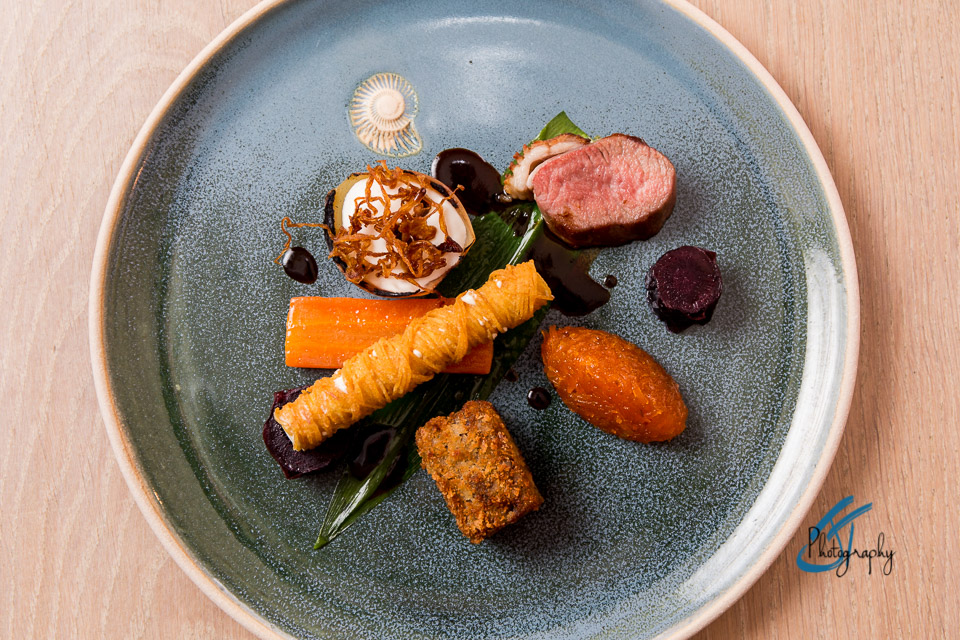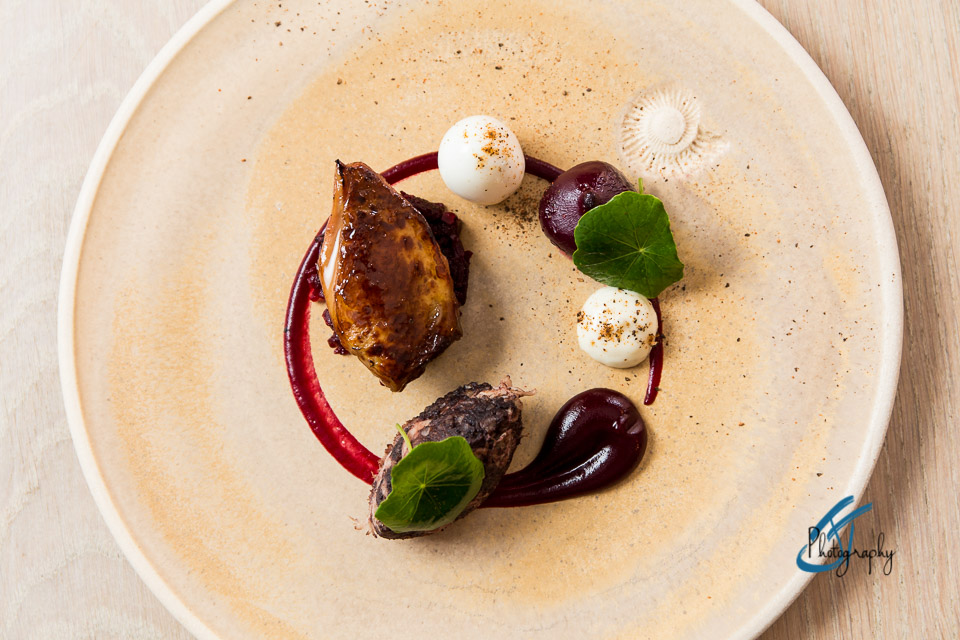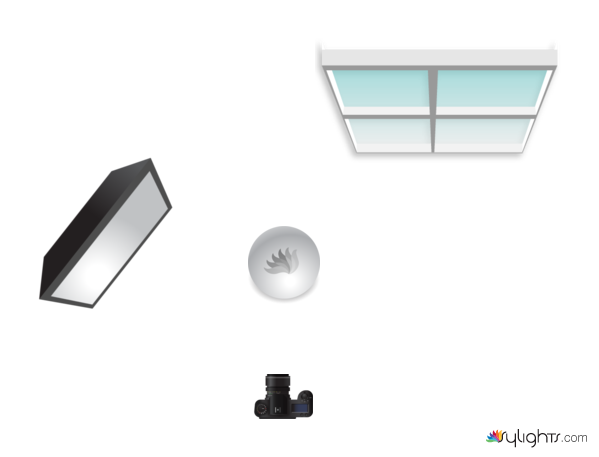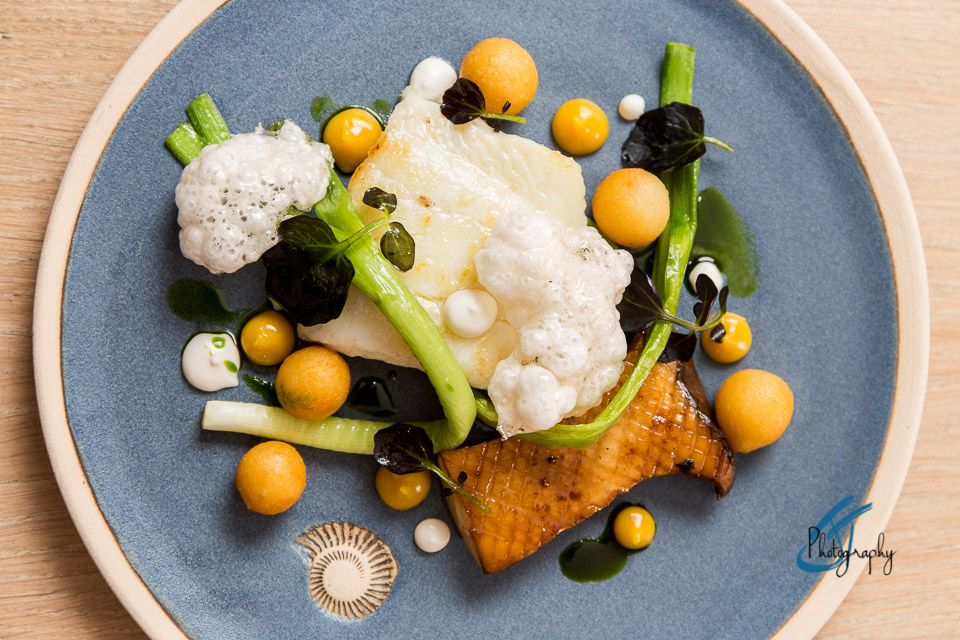Mixing flash with natural light on a restaurant food photography shoot
Following on from my previous post on mixing natural light with strobe in food photography. In that article I showed you how using strobe can freeze any motion within a food photo. This time I’m mixing flash with natural light the opposite way around, using the flash as the key light and the natural, window light as a fill.
The lovely restaurant I had the pleasure of working with was The Lion and Pheasant in Shrewsbury. I would be working with Head Chef Dion Jones and his team to produce some lovely images. The area which I would be photographing in, was close to the kitchen, that way if a dish was time sensitive I would have the most time to get a great shot. There isn’t a huge amount of natural light in this part of the restaurant so you need to be comfortable shooting with artificial light.

The day outside was quite bright so there was a reasonable amount of natural light coming through the windows, but not enough for a low ISO, good exposure. It was a perfect scenario for mixing flash with natural light. I would use my flash as the key or main light source and expose so the natural window light was my fill.
Firstly I metered the window light to see where I was going to have to set my exposure. In this set up my fill light was ⅔ to 1 ½ stops lower than the key light. Why would it change? That’s the joys of natural light, it can change dramatically in a split second. How much fill light you have all depends on the look you want in the final image. Less fill= deeper shadows, more fill= lighter shadows. As long as your fill light is less than your key light you’ll keep dimension to your image. If they match in intensity you could end up with two sets of shadows which isn’t a good look. Remember, shadows are your friends, they give your image texture and shape.

Now for the key light. I could have bounced light off the ceiling to light the scene, which would have worked for sure. This way I would have a big wash of light covering the whole scene, without any direction, which would be too flat for my taste. The key light was my Speedlite in a 76x76cm Lastolite Ezybox, in quite close and feathered off the subject quite a bit towards camera. This means the scene was lit mostly by the edge of the softbox and had direction.


That was it, once my lighting was set up it allowed me to work pretty fast to get numerous required crops of the food.
There you have it, another great way to mix flash with natural light in your food photography. If you’d like to read how I’ve used a similar technique to freeze action in food photography follow this link. As always, if you have any questions leave them in the comments below, I’ll gladly answer them.

See you back here very soon.
![]()

4 Comments on “Mixing flash with natural light in restaurant food photography”
Interesting stuff and useful info Jonathan! I have two quick questions:
Do you always use speedlites as your artificial light source rather than a larger studio light?
Do you use a lightmeter?
Thanks as always for the tips x
Hi Sarah,
Thanks for your questions. Yes I mostly use Speedlites for my flash, especially on location, mostly for their portability. There are many studio strobes which are cheaper but much bigger to carry around. I would also need battery packs to take studio style strobes on location. You never know what access you will have to a power supply. As the light source is usually close and indoors, my Speedlites have more power that I need. Normally I have them at less than half power, depending on if they are the key light or the fill.
Yes I use a light meter, it very quickly tells me where I am with my light levels so I can set exposure or light power where I need it. They’re not essential but they do speed up my workflow. I tend to have a good idea of exposure before I set up, but this is through practice and lots of shooting. You’ve just given me another idea for a post, so thank you Sarah. That’s why I like questions.
Have a great week Sarah and thanks again. :)x
I’m a beginner in food photography. I use my dining table as the main station, I recently made a wooden over board out of some rough wood, which makes the background to the photos, look more like rustic country type table.
The table sits directly in the window, which itself is 80% of the wall.
Should I use extra lighting when taking foody images, would that destroy the whole effect. I suppose one to find out is to suck it and see, however if your not to sure how it should look, when you’ve finished, you would still require someone with an eye for food photography to say yes or no.
Regards
Barry Atkinson
Hi Barry,
Thanks for the question. Sounds like you have a similar set up to me at home, with a large window to use for a light source. Usually I just use the window light and add a white card or reflector to bounce some light back into the shadow side to lift the shadows. If the light is too dim, like a super cloudy, rainy day, then use a tripod and longer shutter speed or up your ISO to make the camera more sensitive to the light you have.
The wooden boards will work very well and you’ll want to use side light to bring out some of the textures in the wood as well as the food. More often with window light I don’t need to add light, more block and flag off light to control how much of it falls into the scene. A bit like creating a gap for the light to shine through, using black foam boards.
There’s no right or wrong way to do it and you’ll only ‘get an eye for food photography’ by shooting it a lot. Copy a couple of styles you like. So many food bloggers show pull back, behind the scenes photos to help you out.
When it comes to lighting, window light or using other light sources, you build the scene. Bring in one light source a a time, so you can see the effect each light source has.
I hope this helps Barry. Stay safe
Regards
JT